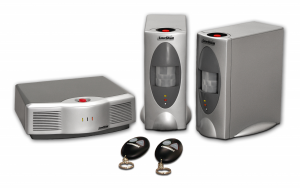Summary:Product development from start to finish
This is a two-part case study. The first part is an example of how a seed of an idea can be turned into a finished product – an example of Clint’s services in product development, offshore manu¬fac¬turing and intellectual property (patent) development. The second part is an example of when taking short cuts can be near-disaster.
Lasershield Case Study

Part 1: It starts with a dream (and some seed money)
This is an example of a start-to-finish project. The founder of Lasershield had worked in the home security industry for more than 20 years. Year after year he heard customer complaints about security systems – too expensive, too complicated, too difficult to install, too easy to trigger false alarms. And year after year he saw alarm manufacturers continue to sell the same old stuff. Finally he decided to take matters into his own hands. Dohrmann wrote a 2-page description of what an alarm system should really be – based on 20 years of listening to customers. Then he raised some seed money, hired a contract-engineering firm and said, “Here’s my product description. Develop it.”

Fast-forward a year and a half: After 18 months, and spending almost $200,000 and going through three different engineering firms, Lasershield had almost nothing tangible to show. A whole lot of money had been spent and whole lot of nothing had been developed. Lasershield was in peril of crashing before it ever got off the ground and the CEO, who had never developed a product before, was wondering if there was anybody out there who could really develop a product from scratch.
Getting a stalled project back into high gear
The company retained Clint as a last ditch effort to turn the idea into reality. Clint’s first step was to flesh out the 2-page product description into a complete functional specification. Surprisingly, none of the other engineering firms had taken this basic first step. The product was complicated and the spec grew to more than 100 pages. The complete system had three different hardware products; there were RF and telephone communication links; and several back-end server systems that had to communicate with one another and with the products. Turning the 2-page “dream” into a real product spec took almost three months, with many hours of questions and answers and brainstorming with the principals of the company. Three months may seem like a long time to spend on developing the product spec, but (here’s the first key lesson in this case study) the effort put into preparing the spec more than paid for itself in the product development phase. The three months spent on the spec cut six to eight months off product engineering – when a half-dozen engineers were working on the project simultaneously.
As the requirements specification firmed up, Clint put together a team to develop the product. Contract firms in Hong Kong and China did the initial engineering. As the product began to take shape, Clint brought in a few key engineers in the US to help the offshore engineers with some of the tougher engineering challenges and to make sure the finished product complied with specifications. Clint shuttled back and forth between the US and China, managing engineering on both sides of the Pacific.
When the first engineering prototypes were almost completed two new tasks had to get started: writing a test plan for the product and finding a manufacturer.
The second key lesson in this case study: The person who writes the requirements spec should never be the same person who writes the test plan. Having one person do both is a recipe for disaster – it’s worse than proofreading your own copy. Clint had written the spec, so he brought in a quality engineer to write the test plan.
With test plan preparation underway, Clint turned his attention to finding a manufacturer for the product – which brings up key lesson number three in this case study: Select your manufacturer as early as possible. There are several reasons for this: (1) You want to make sure that the manufacturer is capable of building what you are designing. (2) The manufacturer can often recommend components, materials and processes that can reduce cost, improve quality or both. (3) Offshore manufacturers can often perform quality and reliability testing at a faction of the cost of domestic test labs.
Clint interviewed about a dozen manufacturers in China and Taiwan, performed audits on the four top candidates, and finally selected a manufacturer (a Hong Kong parent company with a factory in China) who offered the best combination of capabilities, price and quality.

With the test plan completed and the manufacturer engaged, product development became a sprint. The following tasks were checked off as quickly as possible:
Make tools for the plastic parts, assemble the first prototypes at the factory, perform functional testing, complete regulatory testing and submissions, and perform quality/reliability testing.
Ramping up for mass-production required designing and building a lot of custom fixtures for assembly and testing. Clint added a test engineer to the team, and worked closely with the manufacturer to design and build the fixtures. When the factory was ramping up for mass-production, Clint became a nearly full-time presence at the factory, overseeing the start of production.
In parallel with product development, Clint brought in network engineers to develop and deploy the back-end network systems that were essential to the function of the product.
In the course of developing this product, the team generated a lot of core intellectual property (in layman’s terms, they invented a lot of cool stuff). Clint worked with patent attorneys to identify patentable inventions and prepare the patent application.

The product launched, and the Lasershield security system completely rewrote the book on how security systems are designed, manufactured, used and managed.
Follow-up work after the initial product launch included: feature improvements to the product, ramping up a second manufacturer in China, hiring a permanent in-house engineering team for the company, and developing several follow-on products.
This case study illustrates of the scope of services that Clint can offer – product definition and specification; product development from start to finish; setting up offshore manufacturing; preparing patent applications; and building engineering teams.
If you’re in the early stages of developing a new product, and if you would like professional help to turn you idea into reality, please call or email Clint to see if he can help you.
Part 2: A short cut becomes a near-disaster

When Lasershield retained Clint, their vision for the appearance of the product was a set of black pyramids – a large pyramid for the master control unit and smaller pyramids for the motion detectors. The master unit looked like a one-foot-tall model of the Luxor in Las Vegas, and the motion detectors looked like its eight-inch-tall younger siblings.
The CEO of Lasershield showed the pyramid design to Clint during their first meeting, and one of Clint’s first questions was, “Have you done any focus groups? Are you sure people will accept this design?” The CEO said that the design represented strength and security and intimidation, and that this is what you want in a security product.
In the first month after Lasershield retained Clint, he suggested twice more that the company run at least one focus group to get feedback from the target market. The response was essentially, “We don’t have time for that, we don’t have money for that, and we know what the market wants.”
So the product was developed in the shape of a pyramid and the manufacturer made molds and tools for building pyramid-shaped security systems. The manufacturer completed the initial sample build of 30 sets and shipped them to the US – and finally Lasershield ran some focus groups. The response from the focus groups was virtually unanimous (which is quite rare): They liked the features, the price point, the ease of use – they liked every feature except for one, and you already know what it is. They didn’t like the shape of the product and they said they wouldn’t install big ugly black pyramids in their homes.

Lasershield had paid tens of thousand of dollars for tooling to make pyramid shaped products, and Lasershield had committed to a firm date for delivering the first mass-production run to a major consumer electronics retailer – and every participant in three separate focus groups had said they wouldn’t buy the product in its pyramid shape.
Calling this a crisis is an understatement. It could have sunk the company. Fortunately, the CEO of Lasershield responded positively. He noted the positive messages from the focus group – they liked the features, functions and pricing. We contacted the product’s industrial designer and asked how quickly he could create a new design and release CAD files. Clint contacted the factory in China and told them to put production on hold because a new design was coming, and he contacted the electrical engineers and told them that they were going to have to re-layout the PCBs.
The new CAD files were released in less than two weeks. The manufacturer completed tooling (including injection molds) for the new design in six more weeks, and the electronics were re-laid-out while the tooling was being made. The factory made prototypes of the new design, and engineers in the US tested the prototypes. Focus groups in the US gave their blessing to the new design, and three months after the initial focus groups, an overhauled design was rolled into mass-production.
Two lessons: First, focus groups can have great value. Skipping a key step early on can cost much more than it saves. Second, if your product is worth developing, then it’s worth developing right. Recognize the strong points, fix the blemishes, and get the product to market as quickly as possible.
If you want to learn more about when and how and why to run focus groups, please contact Clint.



